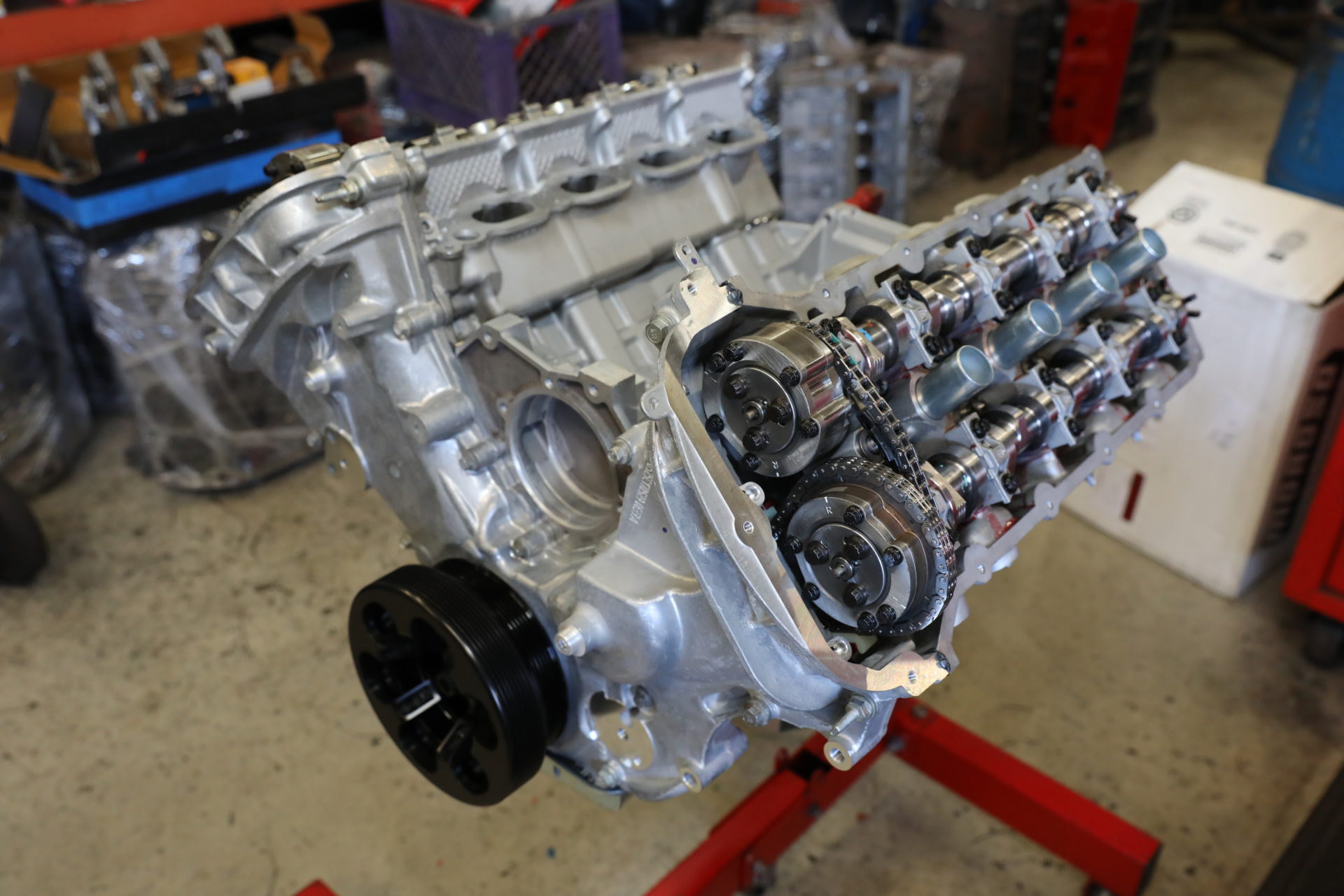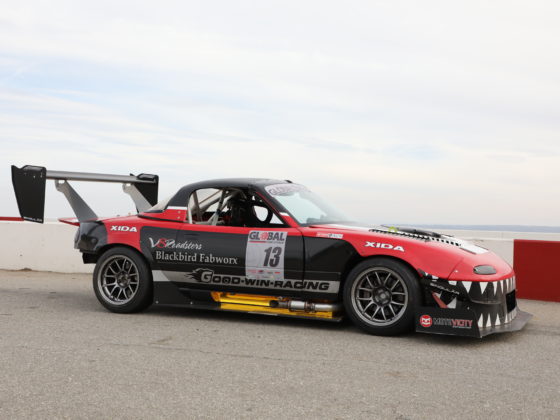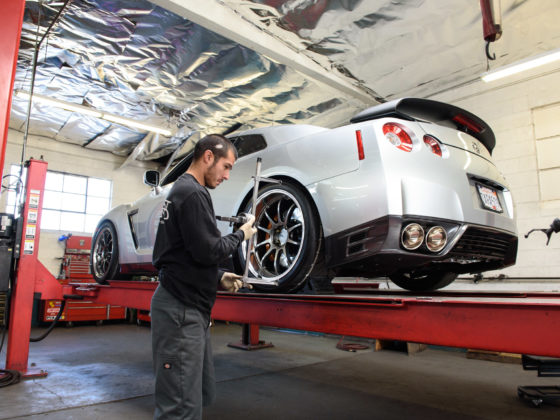,

Stock Coyote blocks can handle around 850 rear wheel horsepower reliably. Beyond that, it’s time to consider dry sleeves from companies like MMR, Darton, or LA Sleeve. The factory gray iron sleeve is only about .062-inches thick. Typically, an aftermarket sleeve at the stock bore diameter will add 30% more material.
Our Build
- Ford Performance BOSS 302 Crankshaft
- K1 Technologies 4340 Steel H-beam rods
- Custom JE 10.5:1 pistons with Tuff Skirt and Thermal Barrier
- High RPM Pulse Ring
The Top End – $200 to $5,000+
Having 32 valves and four camshafts can get pricey when building the top end of a Coyote. The factory chambers flow fairly well but can still benefit from CNC porting with larger valves, normally worth 35-50 horsepower at the crank. Staying on a moderate budget, we kept the chambers stock in our build, but we opted for all new valvetrain.
Stock BOSS 302 springs are an affordable upgrade when sticking with stock-type camshafts, but since we were upgrading to COMP NSR cams with a moderate amount of boost, we opted for COMP Cams PN 26125TS-KIT, which includes new valve springs, tool steel retainers, seats, and keepers. In addition, we went with a new set of stock replacement valves from Ferrea. These stainless steel valves will hold up to the high heat demands of our Coyote under road racing conditions.
Ford Performance does offer upgraded camshafts that work within the means of the stock phasers. For those looking for the maximum power potential, COMP offers their NSR (No Springs Required) camshaft upgrade along with their CR-Series camshafts, built off a 2015+ lobe profile for max effort. In testing, we’ve seen the NSR cams pick up 40-50 horsepower (on an ’11-14 engine) at the crank and the CR-series about 10 more on a naturally aspirated engine. Due to the more aggressive nature of the COMP camshafts, limiters that restrict VCT movement to 20-25 degrees (from 50) are required to eliminate piston to valve issues. Furthermore, the CR-series require upgraded valve springs above 60-pounds of spring pressure. If you’re using a 2015-’17 engine, limiters and valve springs are not required.
Our Build
- COMP Cams NSR Stage II camshafts – PN 191460
- COMP Cams Limiters – PN 5493
- COMP Cams Valve spring and retainer kit – PN 26125TS-KIT
- Ferrea 1.460-inch stainless steel intake valves – PN F2242P
- Ferrea 1.222-inch stainless steel intake valves – PN F2244P
Bolting it Together – $400-$1800
ARP has every critical bolt needed to assemble the inside of a Coyote engine. The most important part is to first determine if your block came with 12mm or 11mm head bolts. Normally, 2011-’12 motors are 12mm and ’13-14s are 11mm. ARP’s main and head stud kits will assure the maximum strength over the stock bolts. They even include the side bolts for the main caps with their main stud kit.

Due to the change in height from the main studs, the factory oil pickup standoff will need to be modified or a spacer from MMR already accounts for this height and can simplify setting pan-to-pickup on a stock-style oil pan.
ARP also builds fastener kits for the phaser to camshaft (factory bolts are one time use), phaser perimeter, cam tower, damper (also one time use), and flywheel.
Our Build
- ARP 11mm Head Stud Kit – PN 256-4301
- ARP Main Stud Kit – PN 156-5803
- ARP Damper Bolt – PN 156-2502
- ARP Cam Phaser Bolt Kit – PN 256-1003
- ARP Cam Tower Bolt Kit – PN 156-1006
Pan Options
When it comes to installing a Coyote into a foreign body, one of the biggest concerns is pan fitment. Is it a front or rear sump? Does it require low clearance? The reality is that some fabrication might be required for a swap vehicle, but Moroso already has a few pans to pick from. Integrated trap door baffles insure oil stays around the pickup during cornering and is a requirement for our road race build, and we stuck with their S197 and Fox body swap pan that allows for an additional quart of capacity. Moroso offers these pans in both steel or aluminum.
When it comes to owning a Coyote engine, it could cost as little as $1600 to well over $16,000. This dual overhead cam engine platform responds awesome in both naturally aspirated or forced induction applications. Now it’s time to get our Coyote into our BOSS 302Revival project!




6 comments
Tons of great information here, thanks for sharing! I’m looking forward to coyote swapping my 97 GT, just trying to figure out how much I really want to spend on the build, and this really helps!
500 HP?? Do you guys really believe this is all they can handle? I’ve been running 609 rwhp in my 2013 F150 for 127,000 miles. Plenty of other guys making alot more than 500 with these engines. Do a little more research next time guys.
We are talking about really handling it, not as a burst through the gears streetcar or 1/4 mile at a time. If yours is holding together at 600 plus with your typical use, that’s great but we are talking about a solid conservative power rating. There is a great possibility that your 600 hp wonder would disassemble itself under the kind of use we subject these motors to.
Whats done to it ?
There’s no way you can find cans for the coyote for 150 to 300 bucks. Your crazy
Blowed mine up first week on the road and made me sick